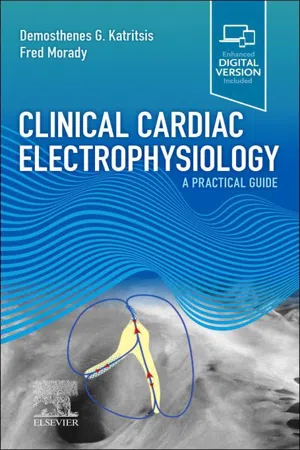
Clinical Cardiac Electrophysiology - E-Book
A Practical Guide
- 392 pages
- English
- ePUB (mobile friendly)
- Available on iOS & Android
About this book
Offering a clear and consistent framework for recognition, diagnosis, and treatment of a wide range of cardiac arrhythmia disturbances, Clinical Cardiac Electrophysiology: A Practical Guide covers the fundamental analytical skills needed in this challenging area. This portable, highly accessible handbook focuses on the basics of clinical electrophysiology— how and when to perform an electrophysiology study as well as principles of ablation and other invasive therapies—all in a succinct and modern format.- Focuses on using an effective, consistent, decision-making process in recognizing, diagnosing, and treating rhythm disturbances of the heart, including supraventricular tachycardias, atrial fibrillation, ventricular tachycardias, and other rapid or irregular heartbeats.- Covers anatomic fundamentals of cardiac structures, clinical indications for electrophysiology studies, practicalities and methodology of performing an electrophysiology study, and problems encountered during the procedure.- Includes quick clinical summaries and more than 180 illustrations: electrophysiology recordings, ECGs, cardiac anatomy, radiographic images, and electroanatomic maps.- Discusses key topics such as mechanisms of arrhythmias, conventional and electroanatomic mapping systems, fundamentals of cardiac mapping, biophysics of catheter ablation, and much more.- Offers real-world guidance on contemporary practice from leading cardiac electrophysiologists Drs. Demosthenes G Katritsis and Fred Morady, with input from a multinational team of electrophysiology fellows and cardiologists.- Ideal as a stand-alone resource or used in conjunction with Dr. Douglas Zipes' renowned textbook, Cardiac Electrophysiology: From Cell to Bedside.
Frequently asked questions
- Essential is ideal for learners and professionals who enjoy exploring a wide range of subjects. Access the Essential Library with 800,000+ trusted titles and best-sellers across business, personal growth, and the humanities. Includes unlimited reading time and Standard Read Aloud voice.
- Complete: Perfect for advanced learners and researchers needing full, unrestricted access. Unlock 1.4M+ books across hundreds of subjects, including academic and specialized titles. The Complete Plan also includes advanced features like Premium Read Aloud and Research Assistant.
Please note we cannot support devices running on iOS 13 and Android 7 or earlier. Learn more about using the app.
Information
1: Classification of arrhythmias
Table of contents
- Cover image
- Title page
- Table of Contents
- Copyright
- Dedication
- Preface
- List of Tables
- List of Illustrations
- 1. Classification of arrhythmias
- 2. Electrophysiologic mechanisms of arrhythmogenesis
- 3. Cardiac anatomy for the electrophysiologist
- 4. Vascular access and catheter placement
- 5. Electrophysiology hardware
- 6. Basic intervals and atrial and ventricular conduction curves
- 7. Electroanatomic mapping and magnetic guidance systems
- 8. Physics of ablation
- 9. Investigation of bradycardias
- 10. Differential diagnosis of narrow-QRS (≤120 ms) tachycardias
- 11. Differential diagnosis of wide-QRS ( > 120 ms) tachycardias
- 12. Atrial tachycardias
- 13. Atrial fibrillation
- 14. Atrioventricular junctional tachycardias
- 15. Wolff-Parkinson-White syndrome and atrioventricular reentrant tachycardias
- 16. Ventricular arrhythmias
- Index